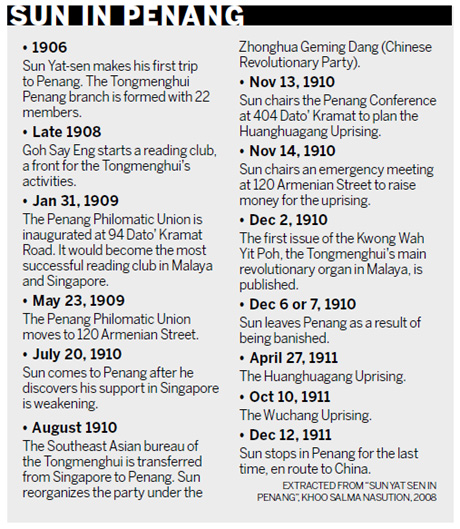|
|
|
Members of the Sun Yat-sen Penang Base outside 120 Armenian Street. [Provided to China Daily] |
The house at 120 Armenian Street could easily be mistaken for just another quaint, rather pretty 19th century dwelling in Penang's George Town heritage zone. It lacks the breathtaking grandeur of the Khoo Kongsi (clan house) or the pomp of the Pinang Peranakan Mansion. But what it lacks in physical splendor, it more than makes up for in historical importance.
This is where Sun Yat-sen launched fund-raising campaigns for the Second Guangzhou Uprising (also known as the Huanghuagang Uprising) and for the Southeast Asian headquarters of the Tongmenghui, his underground resistance movement.
This historic venue is now known as the Sun Yat-sen Penang Base.
|
||||
The following day, Sun started his fund-raising campaign at 120 Armenian Street.
Through a moving speech, he beseeched his close supporters to "help shoulder the responsibility of saving our country by donating your money while our comrades in our country are sacrificing their lives"
Sun raised $8,000 (Straits dollars) immediately. Both events helped the uprising, which tragically failed. But historians believe it triggered the Wuchang Uprising and then the Xinhai Revolution.
Perhaps of equal significance are the four dark and desperate months between July and December 1910 that Sun spent in Penang.
"Sun arrived in Penang a despondent man. With the failure of the eighth uprising, he had lost resources and people. His family was bankrupt. His supporters on the island had been financially stretched by the revolution. Letters to supporters around the world asking for more funds were met with months of silence. Revolutionary fervor appeared to be waning," explained Goh Mai Loon, representative of the Sun Yat-sen Penang Base. "In letters, he recounted that these were among the most difficult times he had faced in his entire life. The whole world, he felt, had abandoned him."
It was during this time that the people of Penang rallied around Sun and helped him regroup. In Sun Yat-sen in Penang, Khoo Salma Nasution, the custodian of the base, writes, "When Sun's family was living in Penang, they could not even afford to pay their monthly house rent of $20. The Penang supporters discussed Sun's situation and undertook to provide his family with $120 or $130 each month for their living expenses While in Penang, Sun received news of his mother's death. As the Sun family was broke at the time, the Penang supporters collected donations for the funeral expenses."
Penang sacrificed too for the China of Sun's dreams. Of the 72 martyrs in the failed Huanghuagang Uprising, four men came from, or had connections to, Penang Luo Zhonghuo, Zhou Hua, Chen Wenbao and Li Yannan.
Others, like Goh Say Eng (Wu Shirong), the founding chairman of the Penang Tongmenghui, gave generously from personal fortunes. Having supported Sun from their first meeting in 1906, the tycoon gradually sold off his family properties to finance the revolution and died a pauper in 1941. Another stalwart and founding vice-chairman of the Penang Tongmenghui, Ng Kim Kheng (Huang Jingqing), also gave away his fortune for the cause.
Untold stories
But time and circumstances seemed to conspire to keep these stories from being told. Not only was the world largely unaware, even most people in Penang and Malaysia remained ignorant of the history makers in their midst. The illustrious history of the base only surfaced in 1992 when Khoo, a conservationist, started researching the area. As it happened, the property belonged to her maternal grandfather, Ch'ng Teong Swee. Khoo convinced her mother, Ch'ng Cheng Ee, to buy the house from the family trust to preserve its history and later converted it into a museum.
It would take another two turning points at 120 Armenian Street to bring about the revitalization of the history of Sun Yat-Sen in Penang. On Feb 4, 2001, then prime minister of Malaysia Mahathir Mohamed visited the base and launched the Sun Yat-sen in Penang exhibition.
"He (Mahathir) told us we had to preserve and promote this history the first time a prime minister of this country recognized the importance of Sun's (time) in Penang. After that, people felt they could talk about their connections to the Chinese revolution," Goh said. The second key event was the April 2002 visit of President Hu Jintao (then vice president of China).
|
 |
